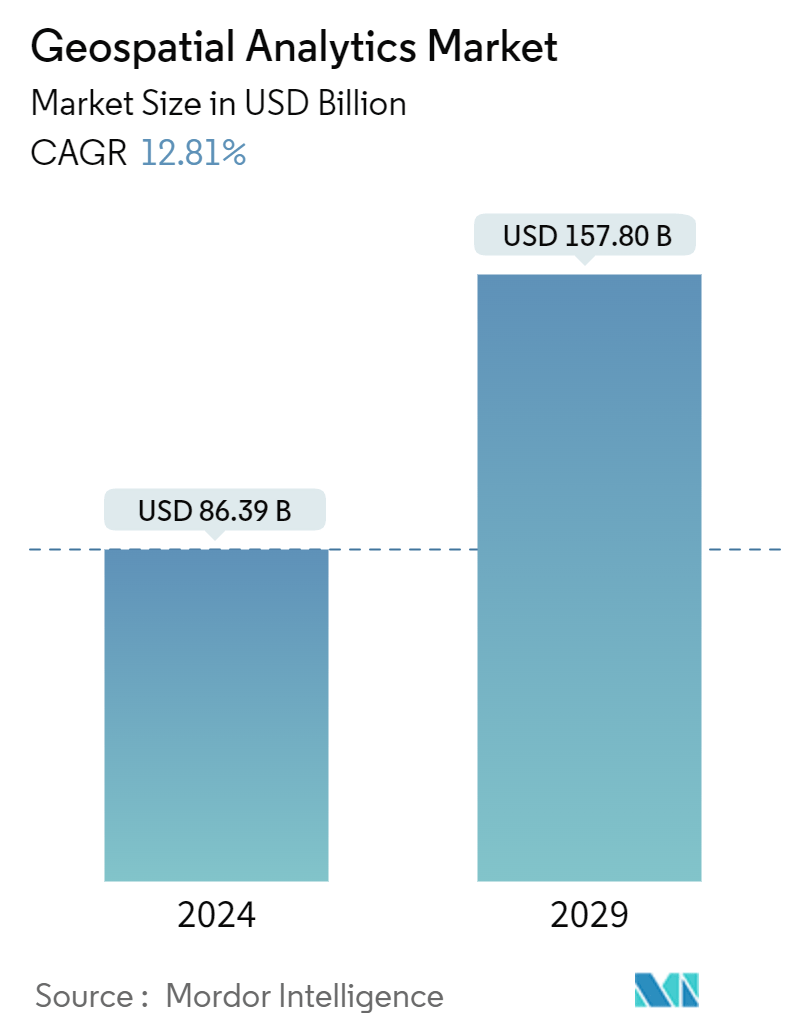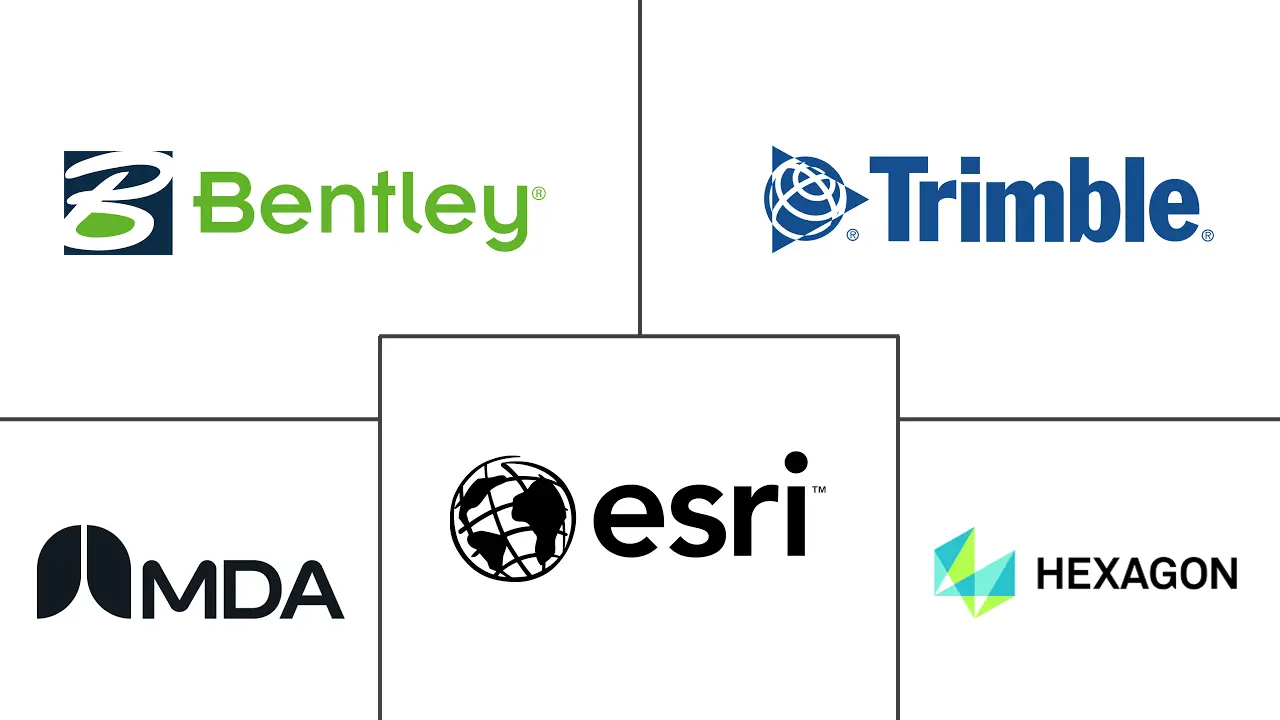Market Size of Geospatial Analytics Industry

| Study Period | 2019 - 2029 |
| Market Size (2024) | USD 86.39 Billion |
| Market Size (2029) | USD 157.80 Billion |
| CAGR (2024 - 2029) | 12.81 % |
| Fastest Growing Market | Asia Pacific |
| Largest Market | North America |
Major Players
*Disclaimer: Major Players sorted in no particular order |
Geospatial Analytics Market Analysis
The Geospatial Analytics Market size is estimated at USD 86.39 billion in 2024, and is expected to reach USD 157.80 billion by 2029, growing at a CAGR of 12.81% during the forecast period (2024-2029).
- Geospatial analysis manipulates, collects, and displays geographic information system (GIS) data and imagery, such as satellite and GPS imagery. Geospatial analysis is based on geographic coordinates and specific identifiers, including street or postal codes.
- In this data-driven industrial age, location information and spatial data using interconnected technologies (augmented reality, big data, artificial intelligence, machine learning, IoT, and 3D technology) are transforming the core of traditional business practices, driving the competitive advantage through data visualization. The need for geospatial content, real-time data, and services at the consumer application and enterprise level is constantly increasing.
- 5G is also expected to aid in addressing environmental challenges such as disaster management and climate change through digital mapping and location intelligence technologies. The connectivity, speed, and capacity of 5G and IoT are expected to reduce greenhouse gas emissions, improve energy efficiency, and enable better renewable resource use. 5G is also anticipated to help improve decision-making about weather, vegetation, and waste management, increasing the requirement for geospatial analytics.
- The driving factor is the increasing acceptance of smart city development. Geospatial analytics solutions have become the platform for smart city growth. Geographic information system (GIS) has become an integral part of everyday life in smart cities. GIS provides an IT infrastructure that integrates all stakeholders and all smart city processes, from planning and design to development and maintenance.
- Geospatial data creation and analysis are extensively utilized in governments, corporations, and scientific fields. Still, the inherent confidentiality features of location data create obstacles for geospatial research and its societal applications. The public concern over privacy was raised with the increasing usage of GIS and related geospatial technologies, and government rules and regulations restrict data gathering, location sharing, usage of location-based information, and data storage. This is expected to hinder the market's growth.
- However, many companies are updating their solutions to automate ML and AI technologies to offer accurate insights. With the advent of 5G technology, this trend will continue to increase during the forecast period. New start-ups are expected to boost the demand for the geospatial analytics market in the near future.
Geospatial Analytics Industry Segmentation
Geospatial analysis uses the data to build infrastructure, graphs and blueprints, statistics, and cartograms, making complex relationships understandable by collecting information, displaying images, geographical coordinates, etc. It monitors the climate and weather, helps retail stores plan their logistics transportation and human population forecasting, and many other solutions depending on the industry.
The geospatial analytics market is segmented by type (surface analysis, network analysis, and geo-visualization), end-user industry (agriculture, utility and communication, defense and intelligence, government, natural resources, and other end-user industries), and geography (North America, Europe, Asia Pacific, Latin America, and Middle East and Africa). The market sizes and forecasts are provided in terms of value (USD) for all the above segments.
| By Type | |
| Surface Analysis | |
| Network Analysis | |
| Geovisualization Analysis |
| By End-user Vertical | |
| Agriculture | |
| Utility and Communication | |
| Defense and Intelligence | |
| Government | |
| Natural Resources | |
| Other End-user Verticals |
| By Geography*** | |
| North America | |
| Europe | |
| Asia | |
| Australia and New Zealand | |
| Latin America | |
| Middle East and Africa |
Geospatial Analytics Market Size Summary
The geospatial analytics market is poised for significant growth, driven by the increasing integration of location-based technologies such as augmented reality, big data, artificial intelligence, machine learning, IoT, and 3D technology into traditional business practices. These technologies are transforming data visualization and providing a competitive edge across various sectors. The demand for geospatial content and real-time data is on the rise, particularly in smart city development, where geographic information systems (GIS) play a crucial role in integrating stakeholders and processes. The advent of 5G technology is expected to further enhance the capabilities of geospatial analytics by improving connectivity and enabling better decision-making in areas like disaster management and environmental monitoring. However, concerns over privacy and data confidentiality pose challenges, potentially hindering market growth.
The market is characterized by the extensive use of geospatial data in government, corporate, and scientific fields, with applications ranging from military operations to planetary mapping. The construction industry in North America is also contributing to the demand for 3D mapping and modeling, as these technologies offer advanced solutions over traditional blueprints. Companies are increasingly adopting cloud-based GIS and exploring the use of VR and AR technologies to enhance their offerings. The market is consolidated, with key players like ESRI Inc., General Electric, Hexagon AB, and others leading the charge through strategic partnerships and technological innovations. These developments, coupled with government investments, are expected to propel the market forward during the forecast period.
Geospatial Analytics Market Size - Table of Contents
-
1. MARKET INSIGHTS
-
1.1 Market Overview
-
1.2 Industry Value Chain Analysis
-
1.3 Industry Attractiveness - Porter's Five Forces Analysis
-
1.3.1 Threat of New Entrants
-
1.3.2 Bargaining Power of Buyers/Consumers
-
1.3.3 Bargaining Power of Suppliers
-
1.3.4 Threat of Substitute Products
-
1.3.5 Intensity of Competitive Rivalry
-
-
-
2. MARKET SEGMENTATION
-
2.1 By Type
-
2.1.1 Surface Analysis
-
2.1.2 Network Analysis
-
2.1.3 Geovisualization Analysis
-
-
2.2 By End-user Vertical
-
2.2.1 Agriculture
-
2.2.2 Utility and Communication
-
2.2.3 Defense and Intelligence
-
2.2.4 Government
-
2.2.5 Natural Resources
-
2.2.6 Other End-user Verticals
-
-
2.3 By Geography***
-
2.3.1 North America
-
2.3.2 Europe
-
2.3.3 Asia
-
2.3.4 Australia and New Zealand
-
2.3.5 Latin America
-
2.3.6 Middle East and Africa
-
-
Geospatial Analytics Market Size FAQs
How big is the Geospatial Analytics Market?
The Geospatial Analytics Market size is expected to reach USD 86.39 billion in 2024 and grow at a CAGR of 12.81% to reach USD 157.80 billion by 2029.
What is the current Geospatial Analytics Market size?
In 2024, the Geospatial Analytics Market size is expected to reach USD 86.39 billion.

